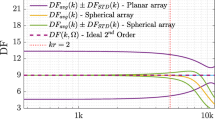Abstract
For a fixed number of microphones, array geometry is the dominant factor to affect beamforming performance for speech signals in immersive environment. Our work, therefore, focuses on the relationship between microphone distribution properties and spatial filtering performance. Array geometries for immersive environments are statistically analyzed to specify the important mic density parameters related to array performance. Feasible optimization algorithms were proposed with the objective function rules using relationship functions and probabilistic descriptions of acoustic scenes to incorporate various levels of prior knowledge of the source distribution. General guidelines in real scenarios were introduced to effectively control the mic distribution parameters related to microphone density, and directly build arrays with superior SNR performance. In addition, arrays mutated from the regular configurations were also introduced to overcome the limitations of regular arrays, and provide good SNR results for speech signals with easily installation.





Similar content being viewed by others
References
Rabinkin, D., Renomeron, R., & French, J. (1997). Optimum sensor placement for array sound capture. Proceedings of SPIE, 3162, 227–239.
Benesty, J., Chen, J., & Huang, Y. (2008). In J. Benesty, & W. Kellermann (Eds.), Microphone array signal processing (vol 1). Springer, Berlin.
Shanan, S., & Pomalaza-Raez, C. (1989). The use of nonuniform element spacing in array processing algorithms. Journal of the Acoustic Society of America, 86, 1416–1418.
Schjaer-Jacobsen, H., & Madsen, K. (1976). Synthesis of non-uniformly spaced arrays using a general nonlinear min–max optimization method. IEEE Transactions on Antennas and Propagation, AP-24, 501–506.
Townsend, P. (2009). Enhancements to the generalized sidelobe canceler for audio beamforming in an immersive environment. MS thesis, Department of Electrical Engineering, University of Kentucky.
Youn, D., Ahmed, N., & Carter, G. (1982). On using the LMS algorithm for time delay estimation. IEEE Transactions on Acoustics, Speech, and Signal Processing, 30(5), 798–801.
Applebaum, S. (1976). Adaptive array. IEEE Transactions on Antennas and Propagation, 24(2), 585–598.
Frost, O. (1972). An algorithm for linearly constrained adaptive array processing. Proceedings of the IEEE, 60(8), 926–935.
Yu, J., & Donohue, K. (2012). Geometry descriptors of irregular microphone arrays related to beamforming performance. EURASIP Journal on Advances in Signal Processing, 2012, 249. https://doi.org/10.1186/1687-6180-2012-249.
Yu, J., & Donohue, K. (2013). Optimal irregular microphone distributions with enhanced beamforming performance in immersive environments. The Journal of the Acoustical Society of America, 134(3), 2066–2077.
Yu, J., & Donohue, K. (2015). Optimization for randomly described arrays based on geometry descriptors. In ICASSP, pp. 549–553.
Bae, J., Kim, K., Pyo, C., & Chae, J. (2004). Design of scannable nonuniform planar array structure for maximum side-lobe reduction. ETRI Journal, 26(1), 53–56.
Acknowledgements
The work was supported by the National Natural Science Foundation of China (Grant: 61501025), FRFCU (Grant: W14JB00540/W15RC00080), and NSFB (Grant: 4172045).
Author information
Authors and Affiliations
Corresponding author
Rights and permissions
About this article
Cite this article
Yu, J., Xv, J. & Yu, F. Geometry Design Based on Microphone Density Analysis. Wireless Pers Commun 103, 773–784 (2018). https://doi.org/10.1007/s11277-018-5476-0
Published:
Issue Date:
DOI: https://doi.org/10.1007/s11277-018-5476-0




